
I was inspired to write this post by a fake currently listed by the Italian auction house Numismatica Felisinea. Out of curiosity I examined the subject, and I realized that many fakes of Mamertini have been sold in recent years…
Pentonkion CNS 34
This is the fake currently auctioned (EDIT 14/06/16 lot withdrawn):


That is not a dangerous fake, as the ridiculous style should make raise a red flag to anyone who is the least familiar with Greek coins, nevertheless this horror fake has been offered on auction even by other “reputable” auction houses in past years, and they continue to list it as genuine! …you know, for the market anything goes. The type that the unexperienced forger wanted to mimic by engraving these modern dies is probably SNG ANS 440
The same fake specimen was sold by the German auction house Emporium Hamburg in 2014:

Another from the same modern dies was offered on auction by the German Busso Peus in 2012:

At this link another sample, with an interesting comment on style by Forvm’s user “helvetica”. Here and here other samples submitted by other Forvm’s users.
Interestingly the same obverse die was used to struck a fake hemilitron of Syracuse, from a private collection, discussed on the Italian forum in 2011.

At this point it is good to make a small digression on this fake hemilitron of Syracuse, because some very interesting thoughts have been shared by the Italian experts who analyzed the coin. Summarizing, the deep but perfectly regular depression seen on reverse is a clear symptom of minting by hydraulic press and certainly not hammer.
Theory says that the internal metal of the coin and the outer layers and patina have different hardnesses and, consequently, a different index of dilation. Observation confirms theory, as the outer layers crack, the original patina “blooms”, flakes, and has blown away. The reason is easy to understand: the interior metal, more tender, expands much more, and it pushes against the more rigid outer layer which cracks, not only along the border, but also in all major stress points. See, for example, the dots at obverse, all “bloomed”. So, be careful with the authentic patinas when cracked, chipped or bloomed.
Flaking layers, albeit light, visible only in a few small areas, it is not at all an ordinary or common phenomenon for the bronze, and it is always a sign that the metal has suffered something abnormal after the original coinage.
The only concern with this coin is the fact that usually counterfeiters level and smooth the surfaces of the two sides of the genuine ancient flan before minting by the fake modern dies, in order to make it receive more clearly the new type.
But here I do not see an underlying smoothing, as I see no trace of any underlying coinages. On the other hand I see that the natural randomness (rusts, small red and green ossiduli, mixed color areas, etc.) can still be seen in their entirety.
All this, in my view, can only mean one thing, namely that the flan before being pressed by the fake dies was virtually devoid now of previous types, it was quite worn and rusty, presenting a similar surface to the one now see you on the edges, that is bumpy and slightly wrinkled.
The forger must have then heated not much the ancient flan and so the temperature of the metal must not been very high and definitely not enough to dissolve oxidations, and it is for this reason that we now we find still almost intact the natural randomness in the midst of new impressed types.
The then re-patination was carried out in a modest way, probably with a compound of minium. Other two experts even gave interesting inputs concerning the bronze disease, which is not necessarily a sign of genuineness for ancient coins, as the chloride ion “does not distinguish between ancient and modern copper“; then it is possible to induce the bronze disease even on modern artifacts, as an artificial bronze disease is achieved quite easily by chlorinated substances, such as hydrogen chloride. This opens truly disturbing scenarios for collectors.
Quadruple CNS 3
Already discussed on the Italian forum. At least three clones for this type are known.
One is currently for sale on the online shop of the Italian seller Crippa Numismatica:

Another one sold by the British auction house Roma Numismatics in 2013:

Another one listed by the German auction house Fritz Rudolf Künker in 2002:

Here the comparison showing they are clones (note different weights):



Mamertini at Adranon, CNS 20
This is a rare issue, Calciati listed only 4 specimens, I’ve found only seven specimens in public collections: Two from ANS collection (here and here), three from BnF (here, here and here), two from BM (here and here). Just look with attention at those genuine samples, look at wear, patina, style. Now, how is it possible that in recent years eight new specimens appeared on the market, all in good conditions? Well, two of them are undoubtedly cast fakes, the remaining six are all from the same new dies not previously seen in public collections, of course I am convinced they fakes struck by modern dies.
First the two cast fakes, both matches with this one I discussed here some weeks ago in a previous post, both sold by the same auction house, the German Gorny & Mosch:

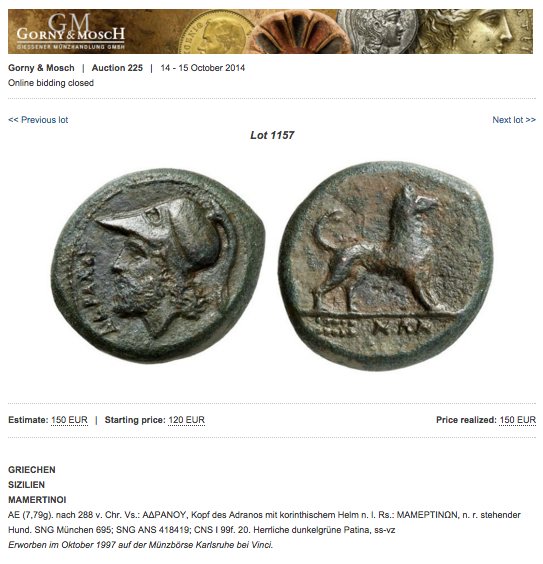
Note the style of the dog, resembling a sort of were-sheep, and the amazing evidence in exergue: Braille code was already used in greek Sicily!!!!! Not to mention the glued patinas. Chapeau to the seller!
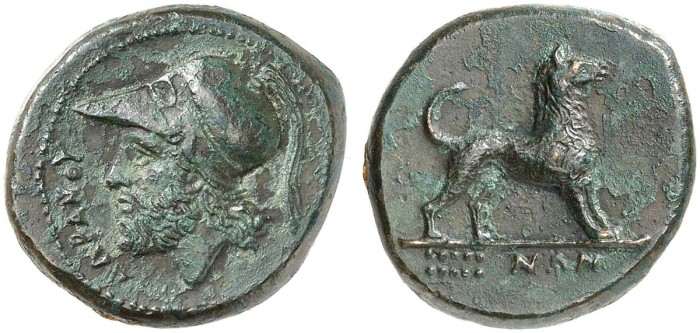


Also worth to note that forgers missed the right weight for this issue, which must be within a range of 4.00-5.70 g, with a.w. of 4,8g (I obtained the data from the genuine specimens in CNS, BnF, BM and ANS).
Here are the six specimens struck by the same modern fake dies, also in this case weights are wrong, and also style is wrong, in particular the “afraid” eye and undulating beard of Adranon, and the dog’s tail on reverse, which on genuine specimens is hairy.
I will list them in chronological order as they appeared on the market:
The New York Sale (2005):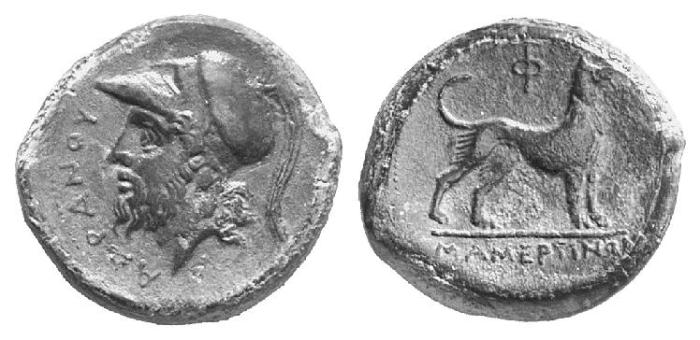
Gorny & Mosch (2007)
Freeman and Sear (2011), ex Stack’s Bowers Sale #150 – Los Angeles ANA Auction lot 8353 (2009)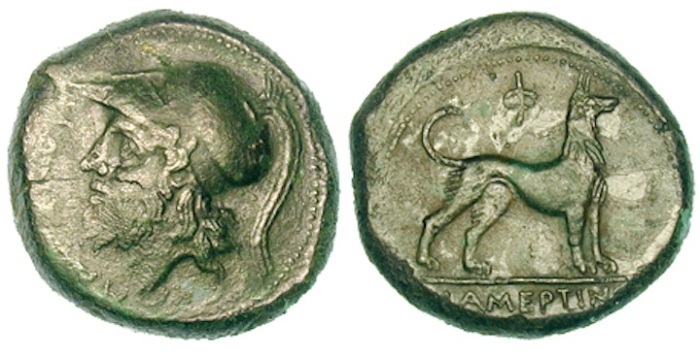
The Notorius fake selle Aitnacoins, two specimens sold on his ebay scam-shop (2011)
Lanz ebay, object n. 231911799104; 33,50 eur final price (2016)

Here the listings of the major auction houses:
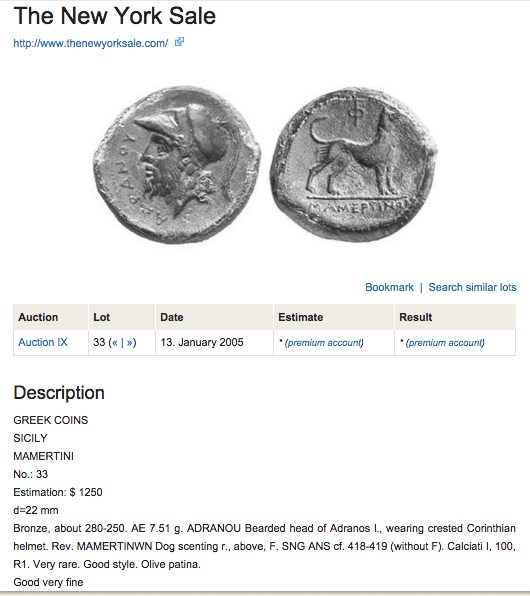


I have 2 fake dies (they were in a large lot of 22 fake dies) that were used to creat some of this fakes.
I have uploaded some pictures here
http://www.forumancientcoins.com/board/index.php?topic=107660.0
I will add your fakes to forgerynetwork, too together with pictures of the fakes dies
Best regards,
Daniel/Amentia/DIN x
LikeLike
the ear of the dog of the The New York Sale specimen is smaller and the obverse is different too
LikeLike